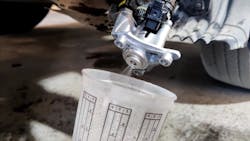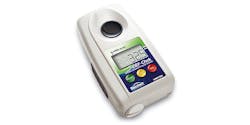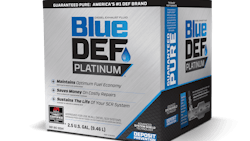In this article, you'll learn about:
- What diesel exhaust fluid (or DEF) does
- How to test DEF to make sure it's still good
- How to prevent and monitor for DEF issues
For more on diesel exhaust fluid:
Even though diesel exhaust fluid (DEF) is a fairly basic chemical mixture—urea (32.5%) and deionized water (67.5%)—it can wind up causing some complex problems for a fleet.
That’s because you need to keep DEF as close to that ratio as possible, otherwise you may experience costly downtime due to upstream issues in the aftertreatment system.
According to the American Petroleum Institute (API), which licenses DEF and makes sure marketers are meeting ISO 22241, issues with low-quality DEF could lead to deposit formations, corrosion, catalyst blockage, and injector or filter clogging.
“Most often we see the DEF injectors get gummed up with crystalized DEF fluid in these situations,” noted Paul Wilson, marketing coordinator at Calibrated Power Solutions, which specializes in tuning and upgrading Duramax engines.
Last month, API also launched a new web resource on DEF quality, purchasing, and storage best practices. And because in less than two years, NOx rules will get more stringent and cause the aftertreatment system to work more efficiently, becoming a DEF whisperer will be even more critical to ensuring fleet uptime.
First off, why do diesel trucks need DEF? The short answer is emissions regulations.
More technically, DEF scrubs Nitrous Oxide (NOx) emissions post-combustion. The fluid is injected into the exhaust stream prior to the Selective Catalytic Reduction (SCR) unit, which heats up to more than 400 degrees F. This catalyzes the NOx to separate into nitrogen, CO2, and water vapor. Simple, right? The problem is that if the urea concentration strays too far from that ideal 32.5%, issues will eventually emerge.
And that’s when basic chemistry turns into a full-blown diagnostic investigation. But that too doesn’t have to be all that complex if your diesel technicians are using the right diagnostic techniques, so let’s examine those.
Tips for testing DEF
When a problem with DEF arises, it will usually be accompanied by a diagnostic trouble code.
“The most common fault code we see is related to low SCR conversion efficiency,” said Mike DeMarinis, training and development manager at Boss Truck Shops, which operates a chain of service centers in 24 states while also providing on-site and emergency roadside service for fleets. “Now keep in mind, conversion efficiency can be low for many reasons. But the first thing we always check is DEF quality. If DEF quality is off, it’s going to cause a conversion issue.”
Testing DEF is quick and easy, which is why DeMarinis trains technicians to test anytime they see a conversion-efficiency fault code. The technician will sample and test the DEF in that vehicle’s DEF tank. Boss Truck Shops utilize unopened 2.5-gallon containers of DEF, so there is typically no need to also test what’s in storage. But for a shop drawing DEF from larger containers like 60-gallon tanks, it wouldn’t hurt to test that DEF as well.
There are two ways to conduct a test.
- Test Strip. This is the simplest method, yet is generally effective within the tolerance range for a proper DEF mixture, which is 31.8 to 33.2% urea. The technician simply draws a sample of DEF, places it on the test strip, and watches to see if the color changes for a simple pass/fail result. Some test-strip makers recommend dipping a strip right into the DEF tank, oftentimes with the help of some kind of secondary extender such as an alligator clip.
- Refractometer. This method is also quick, but more accurate than a test strip. DeMarinis said the entire process takes less than a minute and is as accurate as you can get.
DEF Storage Do’s & Don’ts
Do:
- Rotate stock and use oldest first
- Avoid extreme hot or cold temperatures
- Make sure supplier is providing Certificate of Analysis that shows received product fulfills ISO 22241 requirements
- Clean tanks that previously held another product with distilled or de-ionized water, or on-spec DEF. Do the same with dispensing equipment followed by DEF rinse.
Don’t:
- Cross-contaminate by using pitchers, funnels, and containers also used for other substances
- Add aftermarket additives
- Store in direct sunlight
- Use tap water to clean tanks and dispensing equipment
- Forget to regularly swap out emergency DEF on trucks in accordance with storage guidelines.
With a refractometer, “You will know nearly the exact percentage of urea content in the DEF,” DeMarinis pointed out.
Calibrated Power uses refractometers because they are reusable and simple to use, Wilson said.
With something as touchy as NOx conversion, knowing when DEF is even slightly off is helpful. Then technicians can keep an eye on things and take corrective action before the degradation gets any worse.
There are different types of refractometers. Some are DEF-specific while others are multi-purpose. There are also some that provide a digital readout of the urea concentration. The more traditional style requires the technician to look through an eyepiece to read the urea concentration on a graduated scale. In any event, the technician first draws a sample of DEF and places it on the refractometer’s prism.
Tips to catch and prevent DEF issues early
If stored properly, DEF can often maintain its integrity for anywhere from one to two years. Shelf life can vary by DEF manufacturer, so it’s a good idea to keep an eye on what’s in storage and not allow it to creep too close to its expiration date.
It’s just as important to keep an eye on the environment where the DEF is being stored. It’s not just heat and humidity that a shop should be wary of.
“Urea will begin breaking down at around 86 degrees F,” DeMarinis said. High temperatures above that lower DEF shelf life to six months, according to API. And when temperatures exceed 95 degrees F, you should test the fluid before use.
Keeping DEF out of direct sunlight will help keep the temperature under that threshold, as well as mitigate the harmful effects of ultraviolet light, which breaks down DEF polymer chains. This is known as photooxidative degradation. It’s a reason you see companies such as Old World Industries keep their BlueDEF bottles packaged in boxes.
“On the other hand, DEF freezes at 12 degrees F, so that’s your temperature window for storage,” DeMarinis said.
API also noted that DEF expands by 7% when frozen.
Potential exposure to contamination is another thing to pay attention to. Even water from a leaky shop roof will throw DEF quality out of whack. DeMarinis said a major culprit of contamination is diesel fuel splashing into a vehicle’s DEF tank. And once that fuel is in there, it’s in there for a while. As DeMarinis pointed out, a truck’s DEF tank is typically “topped off” by a driver or technician. Bad DEF contaminates the next batch, and the next and the next—until a technician catches it and empties the tank to start over.
This means technicians should get into the habit of testing the DEF whenever a vehicle is in for service.
“It’s pretty easy to tell when DEF is getting diluted,” DeMarinis said. “It starts to look cloudy. You may also start to see some crystallization building up at the dosing site (i.e. SCR). That crystallization happens because the system is dosing DEF more than it should because the concentration of urea isn’t right.”
Noregon, a provider of diagnostic, repair, and data analytic solutions, said there are other signals that DEF quality may be compromised. For instance, if the DEF in a vehicle’s tank or a storage container in the shop has taken on an especially foul smell, it has almost certainly gone bad. Also, when a vehicle has sat for a long time, the possibility of the DEF going bad is high enough that testing makes a lot of sense.
It makes even more sense because testing DEF is quick, easy, and relatively inexpensive. The same cannot be said about a truck in derate mode or a hefty tow bill. Make a commitment to testing DEF quality on a regular basis now, and you’ll be happy you did later on.
About the Author

Gregg Wartgow
Gregg Wartgow is a freelancer who Fleet Maintenance has relied upon for many years, writing about virtually any trucking topic. He lives in Brodhead, Wisconsin.



